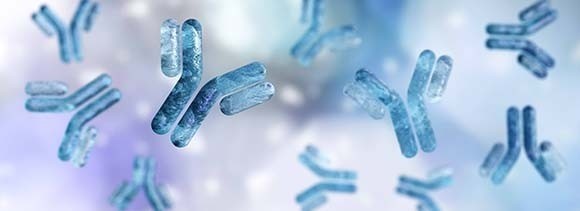The Rise of Monoclonal Antibodies as Blockbuster Drugs
By Dr. Hue-Tran Hornig-Do.
When former President Trump was diagnosed with COVID-19, one of the cutting-edge experimental therapies he received was a mixture of monoclonal antibodies (mAbs). But what exactly are mABs? They are artificial molecules created in laboratories to act as substitute antibodies in fighting diseases. They mimic the body's natural immune response and effectively target foreign agents such as viruses.
The rise of mAbs can be traced back to the groundbreaking work of Köhler and Milstein in 1975, who introduced the hybridoma technique.1 This technique revolutionized the production of pure mAbs on a large scale, significantly advancing both basic research and the potential for clinical application. As of 30 June 2022, there were 162 approved and marketed antibody therapies targeting a variety of diseases, including cancer and infectious diseases.2 The advantages of antibody therapies lies in their high efficacy and safety, making them one of the most effective types of medicine available. In fact, mAbs have become top-selling drugs in the pharmaceutical market.
How do Monoclonal Antibody Drugs Work?
One of the remarkable aspects of mAbs is their versatility in targeting diseases. For instance, mAbs have revolutionized cancer treatment by providing targeted therapies. Antibodies specifically recognize and bind to proteins expressed on the surface of cancer cells. By targeting these specific markers, mAbs can interfere with cancer cell growth, block signalling pathways that promote tumour development, or trigger immune responses against cancer cells.3 This targeted approach minimizes damage to healthy cells and improves the effectiveness of cancer treatment.
In the case of infectious diseases like SARS, monoclonal antibodies can be engineered to bind to specific viral proteins, such as the spike protein of SARS-CoV-2. By binding to these proteins, the antibodies prevent the virus from entering and infecting healthy cells, effectively neutralizing the pathogen.4
"This mechanism of action limits the spread of the virus within the body and reduces the severity of the infection."
How are Monoclonal Antibodies Created?
MAbs are developed in the lab through specialized biological processes.5 This can involve identifying pathogen-specific B-cells in patients who have recently recovered from an infection or by immunizing mice genetically modified to have a humanized immune system and harvesting effective antibodies from them.6 Millions of mAbs are evaluated and the most promising candidates undergo rigorous testing for potency, functionality, and manufacturability. Once selected, mAbs are produced by expressing the genes of immunoglobulin chains in a cell line. The majority of mAbs are grown inside cells obtained from Chinese Hamster ovaries (CHO cells), which are then cultivated in large-scale bioreactors.
Large-scale human monoclonal antibody manufacturing generally consists of several complex steps beginning with “upstream” production of the drug substance, followed by “downstream” processes to purify and formulate the antibody for its method of administration, such as an injection or intravenous infusion.7 Process development optimizes the manufacturing process, ensuring product concentration, quality, and composition. This step is crucial for clinical testing, safety evaluation, and commercial availability of the product.
The Challenges and Future Perspectives of Monoclonal Antibody Development
Monoclonal antibodies are not limited to infectious diseases and cancer; they are also being investigated for autoimmune disorders, neurodegenerative diseases, and cardiovascular conditions. Their versatility and specificity make them attractive candidates for targeted therapies in a wide range of medical fields. However, despite their immense potential, the development and production of monoclonal antibodies poses several challenges. One major hurdle lies in the time and resources required for their creation. From identifying suitable target antigens to generating high-affinity antibodies, the development process can be time-consuming and labor-intensive.
Additionally, mAbs production involves complex manufacturing operations with biologic raw materials as well as rigorous procedures to ensure the tolerability and quality of the final product.8 As such, antibody therapies are more expensive to develop and manufacture than most small molecule medicines. Researchers require advanced solutions to streamline the development process and maintain a competitive advantage. The Fisher Scientific channel offers robust and cost-effective antibody production solutions from market leaders, addressing the challenges faced at every stage of the process, including transfection, clone selection, process control, and scale-up. Discover more about mAbs.
References
1. Kohler G, Milstein C. Continuous cultures of fused cells secreting antibody of predefined specificity. Nature. 1975; 256:495–7.
2. Lyu X, Zhao Q, Hui J, Wang T, Lin M, Wang K, Zhang J, Shentu J, Dalby PA, Zhang H, Liu B. The global landscape of approved antibody therapies. Antib Ther. 2022 Sep 6;5(4):233-257. doi: 10.1093/abt/tbac021.
3. Lu RM, Hwang YC, Liu IJ. et al. Development of therapeutic antibodies for the treatment of diseases. J Biomed Sci. 2020; 27:1. https://doi.org/10.1186/s12929-019-0592-z
4. Zost SJ, Gilchuk P, Case JB, et al. Potently neutralizing and protective human antibodies against SARS-CoV-2 [published online ahead of print, 2020 Jul 15]. Nature. 2020; 10.1038/s41586-020-2548-6. doi:10.1038/s41586-020-2548-6.
5. Pedriolo A and Oxenius A. Single B cell technologies for monoclonal antibody discovery. Trends in Immunology. 2021; 42:12. https://doi.org/10.1016/j.it.2021.10.008
6. Marovich M, Mascola JR, Cohen MS. Monoclonal Antibodies for Prevention and Treatment of COVID-19. JAMA. 2020;324(2):131–132. doi:10.1001/jama.2020.10245
7. Gronemeyer P, Ditz R and Strube J. Trends in Upstream and Downstream Process Development for Antibody Manufacturing. Bioengineering. 2014, 1, 188-212. doi:10.3390/bioengineering1040188.
8. World Health Organization. WHO Guideline for the safe production and quality control of monoclonal antibodies for use in humans. Available from: https://cdn.who.int/media/docs/default-source/biologicals/mabs-manufacture-guideline-draft-for-1st-public-comment.pdf






